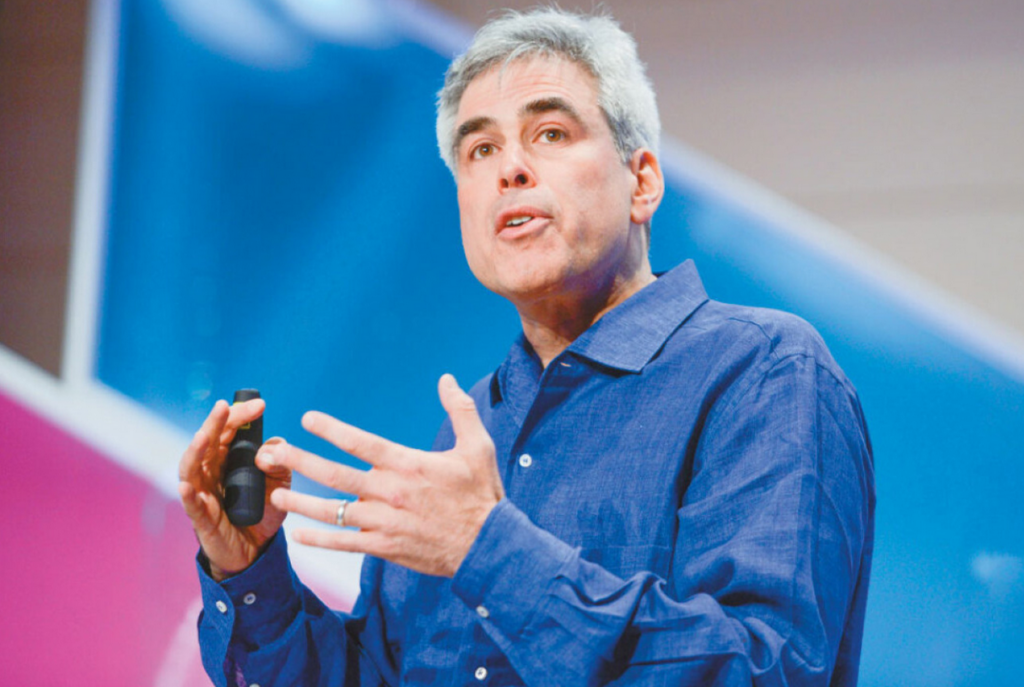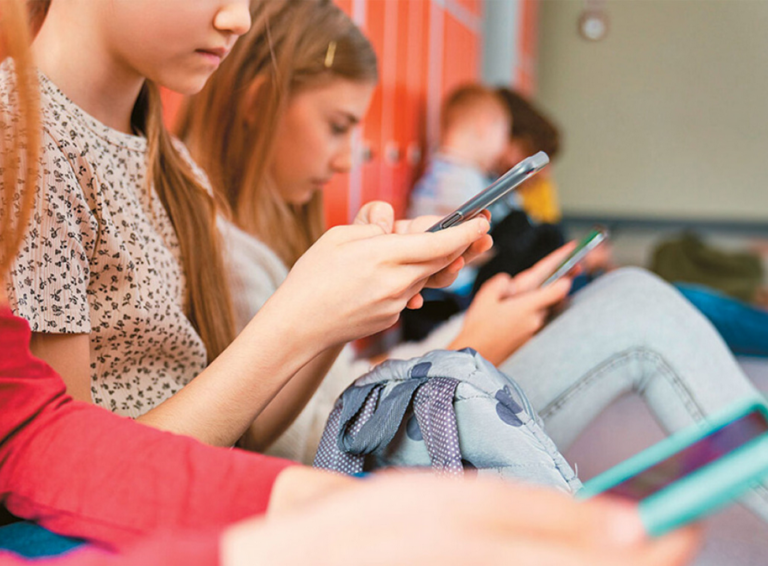In a week, the new school year will begin, which this year is dominated by the announcement from the Ministry of Education regarding the ban on the use of smartphones in schools. One of the reasons for this move was Jonathan Haidt’s book: About one in five people on the planet -one in ten in Greece-belongs to Generation Z, or GenZers, also known as Zoomers. This unofficial demographic cohort includes those born between 1995 and 2010. They are today’s youth, aged 14 to 29, whose path to adulthood has coincided with the digital revolution of smartphones and social media, and the boundless freedom provided by technology, albeit at a steep cost.
These children and teenagers are the focus of Jonathan Haidt’s latest book, titled “The Anxious Generation: How the Great Childhood Rewire is Causing an Epidemic of Mental Illness” (Penguin Press), which was highlighted in an Instagram post by the Prime Minister’s wife, Mareva Grabowski-Mitsotakis, who described it as the most interesting summer read.
“In Jonathan Haidt’s excellent book, ‘The Anxious Generation,’ the impacts of the reckless use of mobile phones and social media on children’s mental health are analyzed, showing how this can lead children to online addiction,” she wrote in her post. “Childhood and adolescence tend to rely on a mobile phone, creating multiplying problems for young people in their lives, their development, and their interpersonal relationships. We cannot afford to ignore the signs.”

In about 100 words, the book’s content is summarized and calls for collective action to address the issue—“we cannot afford to ignore the signs.” The author, Mareva Grabowski-Mitsotakis, is the mother of three children from Generation Z. It is likely that Jonathan Haidt’s daughter also belongs to this generation, as indicated in the book. This gives them even more reason to be concerned—or perhaps not. “The mental health of the youth concerns us all,” emphasizes Mrs. Grabowski-Mitsotakis, according to the author’s note: “This book is not only for parents, teachers, caregivers, or those concerned about children.
It is for anyone who wants to understand how the fastest reprogramming of human relationships and consciousness in human history has made it difficult to think, focus, set aside oneself to care for others, and build strong relationships. The Anxious Generation is a book about how to reclaim life for people of every generation.”
The book’s topic is highly relevant: numerous research findings—such as those extensively cited by Haidt himself—link smartphones to increased levels of anxiety, depression, and suicides among youth. In various schools in the U.S. and Europe, efforts are underway to limit children’s exposure to the internet by banning mobile phones and tablets.
One of the four reforms Haidt suggests from the very first pages of his book is a ban on acquiring a mobile phone before high school and access to social media before the age of 16, along with more unsupervised free time for children.
Thus, he argues, we can restore childhood from screens to playgrounds and neighborhoods, where young people grow and prepare for real life, away from “an alternative universe that is exciting, addictive, unpredictable, and, as it will prove, unsuitable for children and teenagers.” It’s time, the psychologist and professor at New York University will state in an interview, “to put the technology genie back in its magic lamp.”

The Origin of Evil and the Test Subjects on Mars
Smartphones in the hands of Generation Z were like a dangerous space mission: “Children born in the late 1990s were the first generation in history to spend their adolescence in the virtual world. When we gave smartphones to Generation Z in the early 2010s, it was like sending them to grow up on Mars, in the largest uncontrolled experiment humanity has ever conducted on its own children.” On this inhospitable planet, children are exposed to cosmic radiation with subsequent cellular damage, abnormalities in bone, muscle, joint, brain, and cardiovascular development due to the absence of gravity, and the physical and psychological impacts of growing up in an alien environment.
The “Great Rewiring” of childhood, as described in this allegory, spurred a mental health crisis among the youth, which began and started to evolve quietly from the 1990s and early 2000s with the “innocent” early computers and cell phones with flip covers. By 2012, adolescent mental health had dramatically declined. Young people found themselves in an environment of constant online connection and isolation.
The new forms of interaction, with the constant need for validation and comparison with others, continuous exposure to images of perfection, and pressure to conform to new standards, proved toxic and triggered feelings of inadequacy, anxiety, and depression. Haidt cites data from 2015 showing that teenagers with social media accounts spend two hours a day on these platforms, with total screen time—including streaming services like Netflix—amounting to seven hours a day. “One in four teenagers reported browsing the internet ‘almost constantly.’ By 2022, this number had nearly doubled to 46%.”
The new reality had been imposed rapidly, with its potential consequences—especially for the developing brains of children—not fully understood. The effects took time to manifest. In the 1990s and 2000s, personal computers (desktops) and early mobile phones did not leave a negative mark on adolescent mental health but were associated with stable or even slightly improved mental states compared to previous generations. It was the next wave of technological advancements, dominated by smartphones and social media, that brought about the dramatic change.
“The sharp increase in self-harm and suicide rates, combined with self-report studies showing rises in anxiety and depression, decisively disproves those who were skeptical about the existence of a mental health crisis. I am not claiming that the increase in anxiety and depression is solely due to greater willingness to report these conditions (which is a good thing) or due to some teenagers starting to experience normal anxiety and discomfort in a pathological way (which is not good). But the correlation between self-reported distress and changes in our behavior suggests that a significant change occurred in the lives of teenagers in the early 2010s, possibly starting in the late 2000s,” notes the psychologist.
“Suicide is the leading cause of death in the U.S., with 49,449 victims in 2022,” Haidt has stated. In his book, he observes that the suicide rates among teenage girls rose in 2008, peaked in 2012, and saw a significant increase of 167% from 2010 to 2021. “And this leads us to wonder: What changed for pre-adolescent and young girls in the early 2010s?”

Neural Networks with Kardashians and Porn
The new digital reality has brought about fundamental changes in neurobiological processes occurring during childhood, particularly those involved in shaping social and cognitive skills crucial for development into adulthood.
Gen Zers experienced five key elements of childhood differently: free play, slower developmental rates, adaptation, social learning, and development in response to external stimuli. Their path to adulthood has diverged significantly from the traditional trajectory of their predecessors.
They missed out on play, physical and social activities—important for mastering non-verbal communication—conflict resolution, and cooperation, interactions like innocent gossip, teasing, and jokes, experiences that engrain in the brain an understanding of relationships, negotiation, and emotional regulation. Haidt explains that these experiences are crucial for the development of executive function, which is responsible for self-control, focus, and the ability to plan and execute tasks.
In the era of the Great Rewiring, these were replaced by interactions on screens. “Communication through text messages accompanied by emojis will not contribute to the development of brain areas that ‘expect’ to be coordinated through conversations involving facial expressions, changes in tone of voice, immediate eye contact, and body language. We cannot expect children and teenagers to develop adult-level social skills in the real world when their social interactions occur largely in the virtual world.” According to him, these are disembodied, asynchronous, and opportunistic contacts.
Celebrities like the Kardashians opened new avenues in the social media world. Famous merely for their publicity, they brought glamour to the digital world and managed to bypass “one of the most important learning mechanisms for teenagers”: they distracted them from a series of role models that could guide the development of their skills. Girls became trapped in a world of image. Boys found easy access to pornography and content that fulfills immediate desires without requiring the development of social skills.
This new regime disconnected young people from the real world and created a new type of childhood existing in multiple fast-changing high-speed networks. “An inevitable consequence was anomie, as stable and binding moral values cannot exist when everything is constantly fluid. As sociologist Émile Durkheim showed, anomie breeds despair and suicide. This might be why boys and girls who followed different paths through the Great Rewiring ended up in the same place, with a sudden and dramatic increase in the sense that their lives were meaningless,” notes the psychologist.
Overprotective Parents and Unprepared Children
Parents are not blameless for the fragile health of Generation Z. Beyond social media, the blame also falls on overprotective parents, those who restricted their children in the real world without managing to shield them from the threats of the Internet. As a result, young people are unprepared for the challenges of the real world. Due to the former, they are unprepared for real-world challenges. Due to the latter, they experienced overexposure to harmful content from a very young age. According to Haidt’s theory, boys and girls raised in a protective bubble do not find a ground to practice the virtues of adaptability and resilience; they become overly sensitive, timid, and distrustful, unprepared for life’s challenges. They enter what the psychologist calls the “defensive mode.”
“We have over a century of experience in making the world safe for children,” he notes, contrasting parents who were stuck in the fear of 1990s crime with murders and missing children. Overprotective parents eliminated “unsupervised play” and deprived young people of the experience of discovery, of being open to new ideas, managing anxiety better, being happier, and being fortified against risks and threats. “The mania with safety (safetyism) is a deterrent to new experiences. When we elevate the safety of children to a quasi-sacred value and do not allow them to take risks, we prevent them from overcoming anxiety, learning to manage risk, and becoming autonomous—elements necessary to become healthy and capable adults.”
Haidt writes in his book that the “defensive mode” of Gen Z persisted into their entry into the academic community. Known for his criticism of “woke culture,” the social trend that emerged in recent years advocating for awareness and conscious activism against social and various injustices, he states that with the enrollment of Gen Zers in educational institutions, “books, words, speakers, and ideas that elicited little or no controversy in 2010, by 2015 were considered harmful, dangerous, or traumatic.” Modern universities with safe spaces against culture wars, he has declared, have become “foolish places where smart people are silent while others say foolish things.”
Just before the end of his book, Haidt returns to overprotectiveness and the mania for safety, focusing on parents: “Around 2012, when teenagers began acquiring smartphones—and charts started showing the increase in anxiety—something else happened: their parents also got smartphones. These smartphones gave parents a new superpower they didn’t have in the era of flip phones: the ability to track their children’s movements at any time. […] Parents began monitoring their children everywhere, such as when they were on their way to school or out with friends afterward. If something seemed odd, they could call or text, or pressure the child to explain what they did during the day. Whether we think of the phone as ‘the longest umbilical cord in the world’ or as an ‘invisible fence,’ children’s autonomy decreased dramatically when they started carrying them [i.e., smartphones] around. Even if a parent rarely checks the tracker, even if a child never calls their mom to pick them up because their bike chain broke, the mere possibility that it could happen makes it hard for children and teenagers to feel independent, confident, and capable. And it makes it hard for parents to let them become independent.”
Hard Truths or Boomer Theories?
Jonathan Haidt is nearly 61 years old, belonging to the infamous boomer generation—often labeled as rigid and set in their ways. Indeed, there are several points in his book where he sounds like the uncle or family friend reminiscing about the carefree and infinitely better years of his youth. He wants children with scraped knees to grow up in neighborhoods and playgrounds, mocks mandatory safety measures in parks and playgrounds, and “asks” parents to trust their children more and allow them to roam alone at night.
His views are considered controversial. Provocative, biased, and contentious are some of the labels critics of Haidt’s positions assign to him, accusing him of outdated ideas, selective examples, a desire to incite panic, and even of silencing Generation Z’s voices. “I’m not saying that 11-year-olds should be banned from the Internet. I’m saying that the Great Rewiring of Childhood, in which electronic devices replaced playtime, is the main cause of the global epidemic of mental illness among teenagers,” he clarifies and suggests the age of 16 as the starting point for “digital adulthood” according to his own model of age-based rights allocation.
In her review of “The Anxious Generation” in the Washington Post, American author Judith Warner criticizes him for downplaying major stressors that have marked Generation Z, such as the COVID-19 pandemic and the climate crisis.
“Every generation has come of age alongside a catastrophe or under the threat of an impending disaster, from the Great Depression and World War II to threats of nuclear destruction, environmental degradation, overpopulation, and catastrophic national debt. People don’t get depressed when facing collective threats—they get depressed when they feel isolated, lonely, or useless,” says Haidt. “Our world may seem fragmented, but it was the same when I was a child in the 1970s, when my parents were children in the 1930s. It’s the story of humanity,” he will comment elsewhere in the book.
For the psychologist, global events did not become drivers of the mental health crisis among young people, nor did they escalate enough to disrupt mental peace since 2012. The problem is that “global events suddenly turned into posts on social media, through which some young people expressed their feelings about a world that is collapsing, feelings that are contagious in the social media world.”
And, as shown by research from Greek-American Yale professor Nicholas Christakis, which he cites in his book, depressive feelings are more contagious.
He is also accused of presenting the use of smartphones and social media as the cause of the psychological breakdown of young people, rather than a symptom of a society that is itself in a deadlock. “There will certainly be points where I am wrong,” he notes in the book’s preface and reserves the right to make corrections in a future online edition of the work. Harsh truths or biases of a boomer scientist? Anxiety, depression, and suicidal ideation among the young existed even before the rise of new technologies.
However, the constant news about influencers, victims of cyberbullying, and other categories of social network users who have ended up committing suicide likely means something.
Ask me anything
Explore related questions





